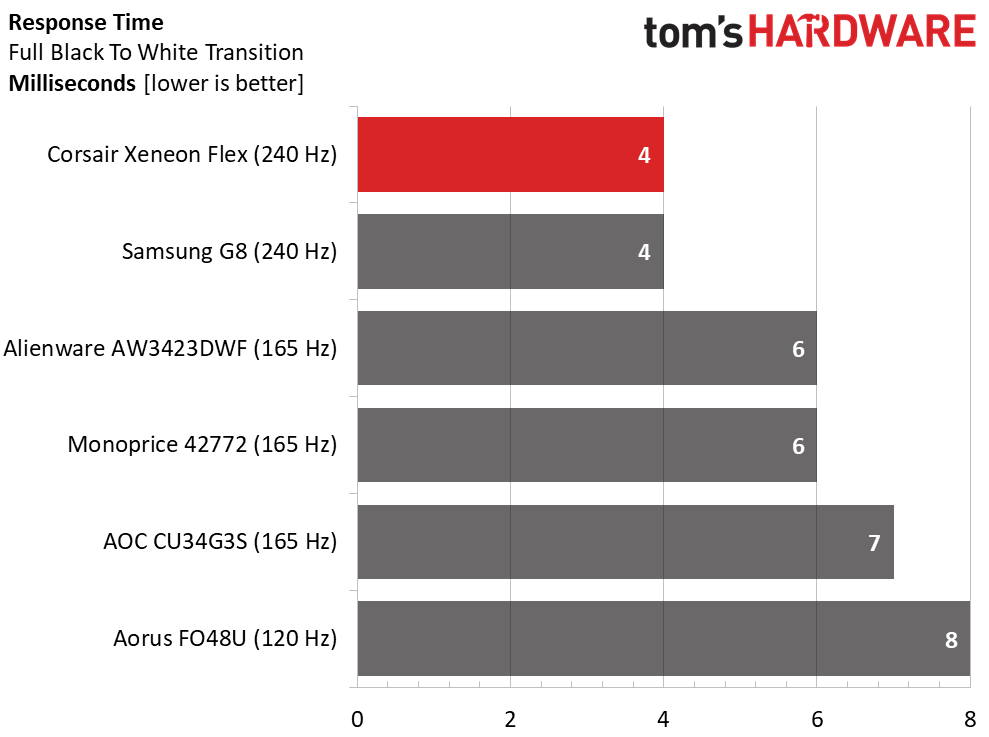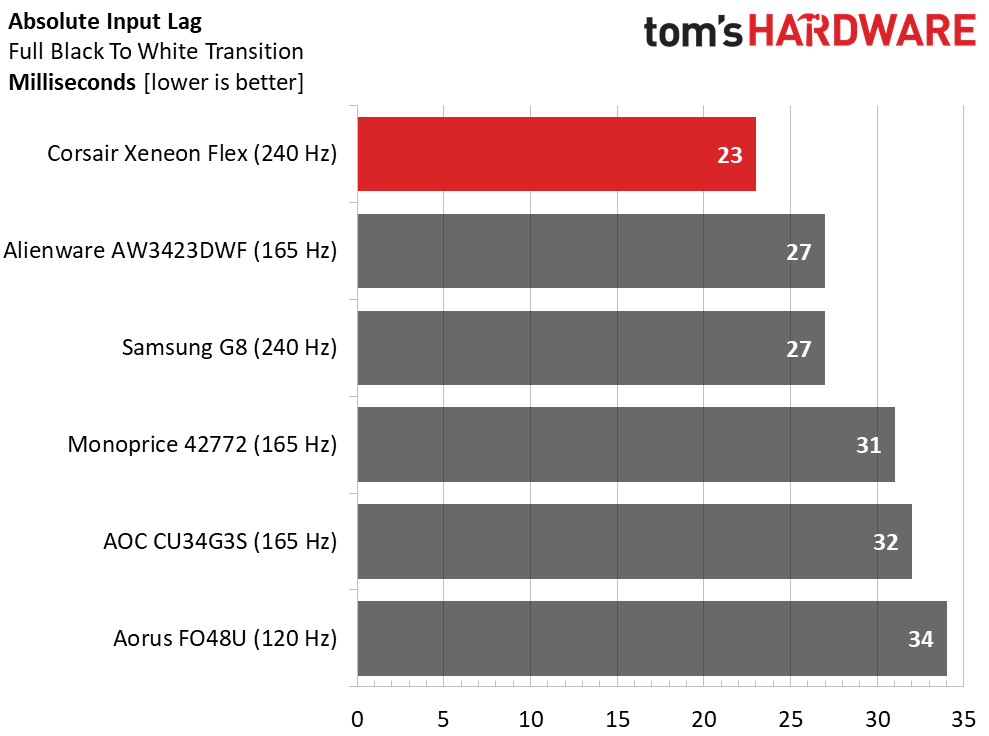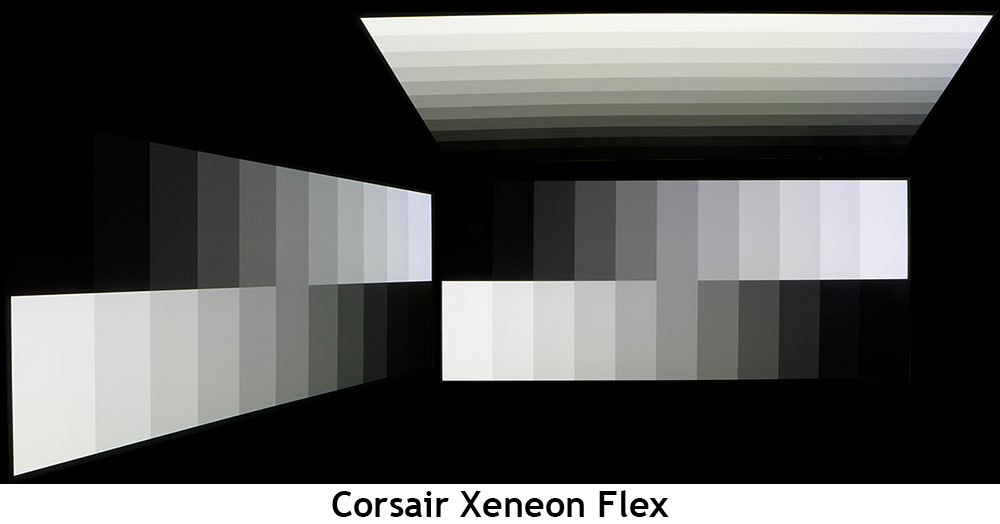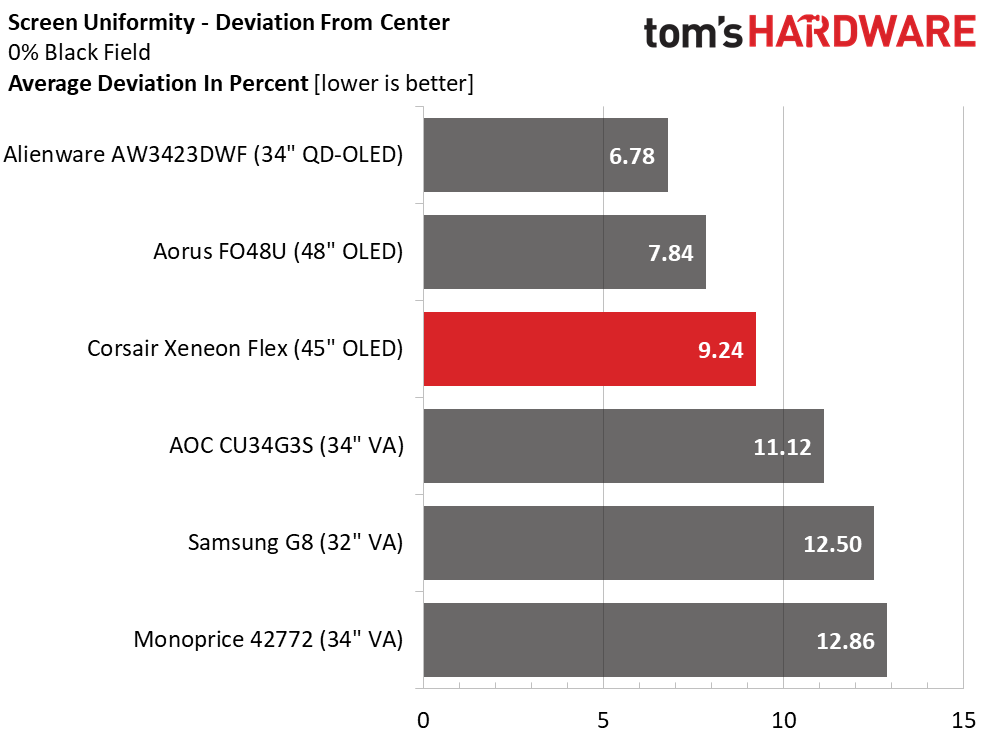Why you can trust Tom's Hardware
To compare the Flex’s performance, I’ve included two OLEDs, the Alienware AW3423DWF and Aorus FO48U. The remaining screens are VA panels, AOC CU34G3S, Samsung G8 and Monoprice 42772.
Pixel Response and Input Lag
Click here to read up on our pixel response and input lag testing procedures.


I included the G8 because it is one of the few speedy VA panels available, and it has contrast and performance on par with the Flex. It and the Corsair can draw a full white field in 4ms thanks to their 240 Hz refresh rates. Observing BlurBusters test patterns show equal smoothness in horizontal movement. The Flex doesn’t need an overdrive to accomplish this and the G8 has a perfectly implemented one. The gaming feel will be equivalent between these two monitors.
In the input lag test, the Alienware sneaks into second place thanks to its snappy OLED screen. The Flex, however, is one of the fastest monitors I’ve tested. Only a 360 Hz screen will be quicker. In practice, it is incredibly responsive and smooth. No matter how rapidly I moved the mouse, the picture never blurred, nor were there any artifacts. The Flex is easily qualified for esports or competitive gameplay.
Viewing Angles
OLEDs have a considerable advantage over LCDs because their polarizing layer is much thinner when viewed off-axis. The Flex looks the same at 45 degrees horizontal as it does head-on. This is a very shareable monitor, especially if you employ the PBP function. It is almost equal to two 32-inch 16:9 panels in total area. From the top, the image looks a bit green and washed out.
Screen Uniformity
To learn how we measure screen uniformity, click here.
I have no complaints about the Flex’s screen uniformity. I had to display a 10% brightness pattern to measure it properly. Black field patterns are too dark to be detected by my instruments. The Flex’s uniformity is visually and measurably perfect in every way.
Get Tom's Hardware's best news and in-depth reviews, straight to your inbox.
MORE: Best Gaming Monitors
MORE: How We Test PC Monitors
MORE: How to Buy a PC Monitor: A 2022 Guide
MORE: How to Choose the Best HDR Monitor
Current page: Response, Input Lag, Viewing Angles and Uniformity
Prev Page Features and Specifications Next Page Brightness and Contrast
Christian Eberle is a Contributing Editor for Tom's Hardware US. He's a veteran reviewer of A/V equipment, specializing in monitors. Christian began his obsession with tech when he built his first PC in 1991, a 286 running DOS 3.0 at a blazing 12MHz. In 2006, he undertook training from the Imaging Science Foundation in video calibration and testing and thus started a passion for precise imaging that persists to this day. He is also a professional musician with a degree from the New England Conservatory as a classical bassoonist which he used to good effect as a performer with the West Point Army Band from 1987 to 2013. He enjoys watching movies and listening to high-end audio in his custom-built home theater and can be seen riding trails near his home on a race-ready ICE VTX recumbent trike. Christian enjoys the endless summer in Florida where he lives with his wife and Chihuahua and plays with orchestras around the state.
-
helper800 We can pick flat or curved and save 50%... I don't get the niche for this product other than, "Look at my monitor, it has two arbitrary modes of rest."Reply -
ThatMouse Very happy with my $250USD - 32" IPS 2560x1440 165Hz monitor while you guys spend all your money.Reply -
helper800 Reply
As an earlier adopter of 1440p at 165hz I paid nearly 600 dollars for it, but this is not a apples to apples comparison, because our monitors are likely substantially different when it comes to response time, perceived blur, brightness, and features.ThatMouse said:Very happy with my $250USD - 32" IPS 2560x1440 165Hz monitor while you guys spend all your money. -
Pollopesca Who is this for? I cant think of a use case for such a feature... I've never sat in front of my curved display and thought to my self "man, I wish I could bend this."Reply -
Sarah Jacobsson Purewal Reply
lol, yeah, of all the things i wish my monitors could do...this is not really high on the list. or...on the list.Pollopesca said:Who is this for? I cant think of a use case for such a feature... I've never sat in front of my curved display and thought to my self "man, I wish I could bend this." -
kjfatl Reply
The main reason for this feature could be "lower shipping cost". Instead of making an extra $300 on the curved monitor, the supplier can make $305 extra. It's not a big deal now, but is will be when the price drops to $199.Pollopesca said:Who is this for? I cant think of a use case for such a feature... I've never sat in front of my curved display and thought to my self "man, I wish I could bend this." -
DavidLejdar Reply
Some users may enjoy the option to switch between flat for work and curved for gaming. Additionally, there may be the argument that for a movie night with several persons, a flat screen is a bit better for the persons sitting on the sides of the couch. And there also is the issue that when someone has a multiple display wall-setup, a curved display may not be that great to have as a side display - and having a display with some flexibility about where it can be used in such a setup, that may be appealing.Pollopesca said:Who is this for? I cant think of a use case for such a feature... I've never sat in front of my curved display and thought to my self "man, I wish I could bend this."
Not saying that it would be enough of an argument for me personally to spend that much on it. Just naming some examples of what some may find quite nice about it. -
Sleepy_Hollowed I was about to do backflips when it said that it had low pixel density (something like 2560 X 1080 or 2560 x 1200), but alas, that's way too high for mortals.Reply
I think it might be priced for the target audience, people who can just buy a top of the line GPU, or someone making content for both flat and curved displays, to quickly test them, though I don't know how much it might last doing that constantly. -
sgtkeebler Dang, I really want this monitor 4k at 240 refresh rate, and it also curves too. Sign me up.Reply

